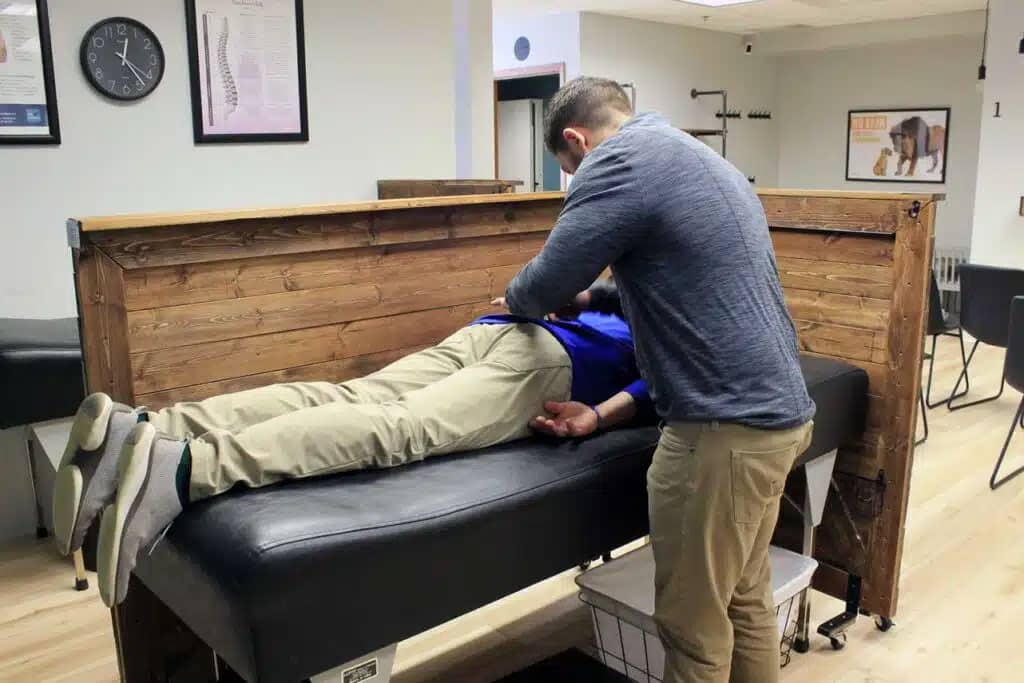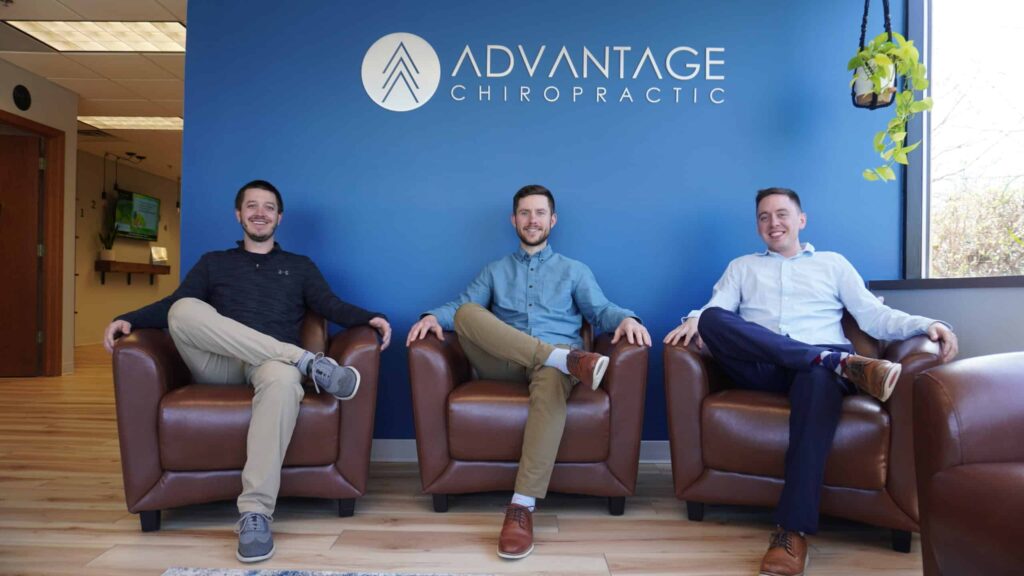
Chiropractic Care for Back Pain
Back pain, including lower back pain, a pervasive medical issue in the United States, impacts countless individuals. It ranges from a persistent ache to a sudden shooting pain down the leg. It can strike unexpectedly, caused by accidents, falls, or heavy lifting, or it can gradually develop due to age-related changes in the spine. Inflammatory arthritis disorders or other medical conditions can also contribute to back pain.
Treating back pain depends on the cause and symptoms, which often involve multiple factors. Therefore, you can improve your health and reduce the likelihood of chronic or long-lasting pain.
At Advantage Chiropractic in New Berlin, Wisconsin, we specialize in providing comprehensive care for all types of back pain. Our board-certified chiropractors for back pain are trained in the highly effective Torque Release Technique (TRT), addressing pain and related issues.
Our Back Pain Chiropractors in New Berlin, WI

Dr. Evan Norum
BOARD CERTIFIED IN CHIROPRACTORS

Dr. Taylor Moore
BOARD CERTIFIED CHIROPRACTORS
Our Unique Treatment Approach
Advantage Chiropractic is known for its unique treatment approach that distinguishes us from other chiropractic care providers. Our methodology is centered around the non-invasive and gentle Torque Release Technique (TRT), complemented by a range of holistic practices to address various back pain conditions effectively. We proudly offer an approach that stands out for its effectiveness and focus on holistic wellness.
Torque Release Technique (TRT):
- Non-Invasive and Gentle: TRT is renowned for its non-invasive nature. This means we can offer treatment without needing more aggressive techniques, which can relieve those apprehensive about chiropractic adjustments.
- Focused on Natural Healing: TRT works by aligning the spine and restoring nervous system function, enabling the body’s natural healing processes. This alignment is vital to not only relieving current discomfort but also preventing future episodes.
- Patient Comfort and Safety: We prioritize your comfort and safety above all. TRT is a technique that reduces the physical stress of adjustments, making it a comfortable experience even for those new to chiropractic care.
- Effective for a Range of Conditions: Whether you’re dealing with acute lower back pain, chronic issues like sciatica, or even more complex conditions like herniated discs, TRT has shown remarkable efficacy in treating a broad spectrum of back-related problems.
Causes of Back Pain
Back pain has become a common problem in our modern lifestyle, characterized by prolonged sitting, insufficient physical activity, and poor posture. Apart from these, there are other factors such as obesity, arthritis, kidney stones, and urinary tract infections which also contribute to this issue. At Advantage Chiropractic, we follow a holistic approach to diagnose and treat the various causes of back pain. We want you to know that we want you to know that we aim to offer you a comprehensive understanding of your condition and provide effective management to help you recover.
Back Pain Conditions We Treat
Our expertise encompasses a wide range of back pain conditions, each requiring a personalized treatment plan:
Lower Back Pain
Lower back pain is often caused by muscle strains or ligament sprains, which can happen due to overexertion, improper lifting techniques, or sudden movements. Symptoms of lower back pain can include sharp pain, limited mobility, and muscle spasms. Fortunately, chiropractic care can be very effective in treating these conditions. By focusing on alleviating pressure on the nerves and muscles in the lower back, restoring alignment, and promoting natural healing, chiropractic care can help ease discomfort and restore normal function.
Sciatica
Sciatica refers to the pain that radiates from the lower back to the legs, usually affecting one side of the body. Sciatic nerve pain commonly occurs due to the compression or irritation of the sciatic nerve, often caused by a herniated disc or bone spur. Patients may experience sharp pain, numbness, or a burning sensation along the nerve. Our chiropractic approach involves spinal adjustments to alleviate nerve pressure and targeted exercises that strengthen the back and improve flexibility, effectively relieving sciatica symptoms.
Herniated Discs
When the soft inner material of a spinal disc protrudes through a tear in the outer layer, it leads to a herniated disc. This condition often causes nerve irritation and pain. Symptoms associated with herniated discs vary based on location and may include back pain, numbness, or limb weakness. Advantage Chiropractic primarily uses spinal adjustments to relieve pressure on the affected discs and nerves as our treatment plan for herniated discs. Our approach revolves around the Torque Release Technique (TRT), which aims to realign the spine, reduce nerve irritation, and promote natural healing. This technique offers a practical, non-invasive solution for herniated disc relief.
Scoliosis
Scoliosis is a condition characterized by an abnormal curvature of the spine, which can cause pain, reduce mobility, and, in severe cases, lead to breathing difficulties. Our chiropractic care for scoliosis focuses on spinal adjustments to improve alignment and reduce discomfort. We also provide posture correction exercises and stretches to strengthen the spine and alleviate the symptoms of scoliosis.
Spinal Stenosis
Spinal stenosis is a condition where the spaces within the spine become narrow, causing pressure on the nerves that travel through it. Spinal stenosis can result in symptoms like pain, numbness, and muscle weakness. Our approach to treating spinal stenosis involves spinal adjustments to open up these spaces and alleviate nerve pressure. We may also use decompression techniques to relieve symptoms further and improve overall spinal health.
Disc Bulges
Disc bulges and herniations are common causes of back pain. A bulging disc occurs when a disc extends beyond its normal boundary, while a herniated disc happens when the outer layer of the disc ruptures or tears. These conditions can compress spinal nerves, leading to pain, numbness, or weakness. At Advantage Chiropractic, we focus on realigning the spine to alleviate disc pressure and treat disc bulges and herniations. We use the Torque Release Technique (TRT), a non-invasive method to correct spinal misalignments, reduce nerve compression, and alleviate discomfort. This approach emphasizes spinal health and alignment, offering an effective solution for relieving symptoms associated with disc bulges and herniations.
Subluxations
Subluxations occur when one or more vertebrae in the spine move out of their proper position, resulting in pressure or irritation on the spinal nerves. This can lead to pain, dysfunction, or an imbalance in normal body function. Various factors, such as physical trauma, stress, or toxins, can cause subluxations. Our chiropractic care focuses on correcting subluxations through precise adjustments, which restore proper alignment and nerve function.
Activities Benefiting from Our Treatment
Our chiropractic care benefits individuals across various activities and professions, including office work, driving, manual labor, gardening, housework, and sports, ensuring that a broad spectrum of patients can achieve relief and an enhanced quality of life.
FAQs
- Is Chiropractic Care Safe? Yes, particularly with our TRT approach.
- How Many Sessions Will I Need? Our approach is tailored to meet the unique needs of each individual. We offer personalized plans to help you achieve your goals.
- Does Insurance Cover My Treatment? We assist with coverage queries and options.
- Can I Continue Physical Activities? We offer tailored recommendations based on your condition.
- What Other Therapies Are Offered? Our treatments may include therapeutic exercises, massage therapy referrals, and lifestyle modifications.

Back Exercises and Stretches Video
Ready to Get Started?
People who suffer from repeat episodes of low back problems usually find that maintaining healthy spinal function and following an exercise program that’s designed specifically for them can effectively reduce the prevalence of back issues episodes in the future. If you or a loved one are struggling with lower back pain, chiropractic care provides a safe and effective way to manage your pain and heal. Your first step on your path to wellness and a pain-free life is contacting Advantage Chiropractic today to schedule an appointment.

About the Author
Dr. Evan Norum, co-owner of Advantage Chiropractic in New Berlin, WI, holds a Doctorate of Chiropractic from Northwestern Health Sciences University. Inspired by personal experiences with chiropractic care, he specializes in family-based treatments and is board-certified in chiropractic care, neuropathy, and the Torque Release Technique®. With internships at leading chiropractic centers and co-founding Advantage Chiropractic in 2017, Dr. Evan Norum is dedicated to promoting health from within.

